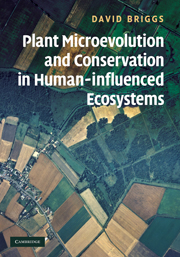Book contents
- Frontmatter
- Contents
- Preface
- Acknowledgements
- List of abbreviations
- 1 Introduction
- 2 Studying change
- 3 Key concepts in plant evolution
- 4 The origin and extent of human-influenced ecosystems
- 5 Consequences of human influences on the biosphere
- 6 Categories
- 7 Investigating microevolution in plants in anthropogenic ecosystems
- 8 Plant microevolution in managed grassland ecosystems
- 9 Harvesting crops: arable and forestry
- 10 Pollution and microevolutionary change
- 11 Introduced plants
- 12 Endangered species: investigating the extinction process at the population level
- 13 Hybridisation and speciation in anthropogenically influenced ecosystems
- 14 Ex situ conservation
- 15 In situ conservation: within and outside reserves
- 16 Creative conservation through restoration and reintroduction
- 17 Reserves in the landscape
- 18 Climate change
- 19 Microevolution and climate change
- 20 The implications of climate change for the theory and practice of conservation
- 21 Overview
- References
- Index
9 - Harvesting crops: arable and forestry
Published online by Cambridge University Press: 05 June 2012
- Frontmatter
- Contents
- Preface
- Acknowledgements
- List of abbreviations
- 1 Introduction
- 2 Studying change
- 3 Key concepts in plant evolution
- 4 The origin and extent of human-influenced ecosystems
- 5 Consequences of human influences on the biosphere
- 6 Categories
- 7 Investigating microevolution in plants in anthropogenic ecosystems
- 8 Plant microevolution in managed grassland ecosystems
- 9 Harvesting crops: arable and forestry
- 10 Pollution and microevolutionary change
- 11 Introduced plants
- 12 Endangered species: investigating the extinction process at the population level
- 13 Hybridisation and speciation in anthropogenically influenced ecosystems
- 14 Ex situ conservation
- 15 In situ conservation: within and outside reserves
- 16 Creative conservation through restoration and reintroduction
- 17 Reserves in the landscape
- 18 Climate change
- 19 Microevolution and climate change
- 20 The implications of climate change for the theory and practice of conservation
- 21 Overview
- References
- Index
Summary
In The Variation of Animals and Plants under Domestication, Darwin (1905, vol. 390) considered an issue raised by Loiseleur-Deslongchamps in his book Les Cereales. As cereal crops have evolved under domestication, perhaps the weeds infecting the fields in which these crops have been grown have also changed. It is interesting to quote Darwin's reaction to this point and his cautious conclusion.
Loiseleur-Deslongchamps has argued that, if our cereal plants have been greatly modified by cultivation, the weeds which habitually grow mingled with them would have been equally modified. But this argument shows how completely the principle of selection has been overlooked. That such weeds have not varied, or at least do not now vary in any extreme degree, is the opinion of Mr H C Watson and Professor Asa Gray, as they inform me; but who will pretend to say that they do not vary as much as the individual plants of the same sub-variety of wheat? We have already seen that pure varieties of wheat, cultivated in the same field, offer many slight variations, which can be selected and separately propagated; and that occasionally more strongly pronounced variations appear, which as Mr Shirreff has proved, are well worthy of extensive cultivation. Not until equal attention be paid to the variability and selection of weeds, can the argument from their constancy under unintentional culture be of any value.
- Type
- Chapter
- Information
- Publisher: Cambridge University PressPrint publication year: 2009

